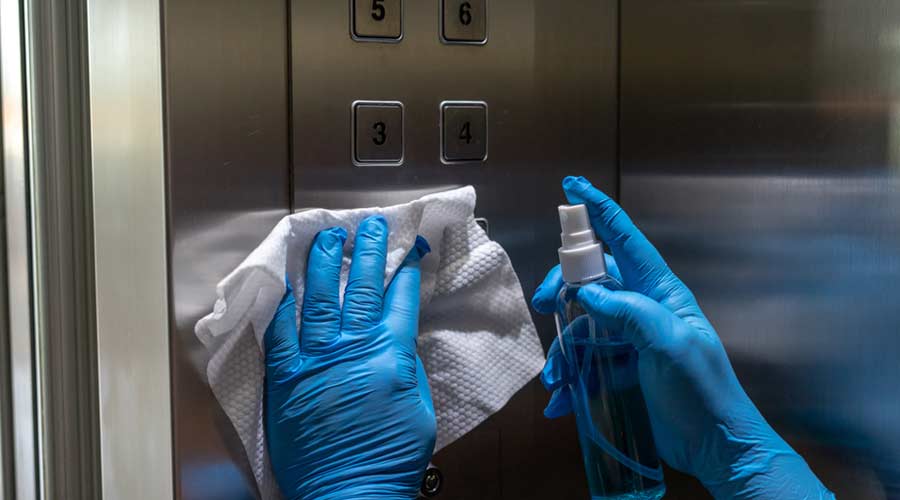
There have been some large changes to professional cleaning in recent years, making it difficult to building service contractors to keep pace. For this roundtable, Contracting Profits tapped into four experts from various areas of the country to discuss trends with facilities customers and big-picture projections.
Experts included are:
- Steve Garcia, Vice President of Operations of Clean Team Inc.
- Paul Greenland, Partner of Ikigai Management Consultants
- Jason Dinverno, Chief Experience Officer (CXO) and Managing Partner for Prestige Maintenance USA
- Heather Parker, Vice President of Multi-Family Operations at CleanOffice/PorterPlus
Customer Service
What is the current state of in-office work and how has it impacted your service offerings/client base?
PARKER: Given that our headquarters are located in the suburbs of the nation’s capital, we’ve observed firsthand the impact of recent federal policy shifts, particularly the rollback of previous telework initiatives. As a result, many commercial office buildings in the area are experiencing increased foot traffic. However, enforcing return-to-office policies has proven more challenging in the private sector, leading to a mixed landscape where some buildings remain underutilized.
The current political environment will continue to shape how private companies approach telework and return-to-office mandates. In this evolving context, it’s essential for service providers to diversify their offerings and target commercial sectors that are less affected by these fluctuations. Fortunately, our early strategic move, diversifying into the multi-family housing market over a decade ago, has positioned us well. This sector has remained stable and largely insulated from the volatility surrounding telework policies, allowing us to maintain consistent service demand.
GARCIA: The entire industry took a big hit after COVID-19. We have seen the shift back to in-office work steadily increase over the last couple of years. Will it ever go back to the pre-covid days? I’m not so sure as companies also found efficiencies and beneficial work patterns throughout the ordeal.
GREENLAND: We have been able to “right size” our staffing based on occupancy.
DINVERNO: Hybrid and remote work have led many office clients to reduce cleaning frequency, shifting from daily to fewer service days. We've adapted by offering flexible service models and adjusting staffing to align with evolving occupancy patterns and client needs, while also seeing continued growth in sectors like retail and distribution, where demand remains strong.
With building occupants paying more attention to their surroundings, are you noticing an increased demand for specific services?
GARCIA: From our customers' perspective, I think there is a greater awareness and need for disinfection throughout the workspace. Although spray disinfection services have been greatly reduced after COVID-19, customers are requesting services more in tune with how a typical medical facility would be cleaned. [That means] more disinfection throughout the facility instead of just restrooms, breakrooms and common areas. We are performing more periodical disinfection services in office and personal spaces than we did before.
GREENLAND: Not any more than usual.
DINVERNO: Yes, we’ve seen a continued emphasis on high-visibility cleaning, particularly in areas like restroom care, disinfection, odor control, and touchpoint cleaning. As building occupants have become more aware of their surroundings, clients increasingly view these services as essential to maintaining safety, comfort, confidence, and peace of mind in the workplace.
PARKER: The demand for certain services post-COVID is highly dependent on the specific client base and market segment a business serves. While some sectors have seen shifts in expectations or service needs, we are not observing a significant increase in requests for services that would be considered out of the ordinary. This reinforces the importance of understanding each client’s unique environment and tailoring offerings accordingly.
How are you staying current with public health guidelines and infection control protocols?
GARCIA: We still utilize our state health department bulletins and industry best practice models.
GREENLAND: Contracting Profits, of course!
DINVERNO: We stay current with public health guidelines and infection control protocols by regularly reviewing updates from the CDC, OSHA, and EPA, and by maintaining strong relationships with our chemical and equipment suppliers. We also provide ongoing training for our teams to ensure alignment with the latest best practices in cleaning, disinfection, and workplace safety.
What products or practices are most effective for maintaining indoor air quality in high-traffic spaces?
DINVERNO: Maintaining indoor air quality in high-traffic areas starts with proper floor care. For hard floors, using HEPA-filtered vacuums, auto-scrubbers, and dust-control pads helps minimize airborne particles. For carpets, regular vacuuming and periodic extraction or encapsulation cleaning are key. We also use low-VOC, Green Seal-certified products to reduce chemical impact and support a healthier indoor environment.
GARCIA: Utilization of high-performance equipment and HEPA filtered vacuums is key, also work specifications geared toward dust control and cleanliness is our biggest contribution to workplace indoor air quality.
Future of Cleaning
What’s your outlook for BSCs and the cleaning industry over the next three years?
PARKER: At the onset of the COVID-19 pandemic, our industry was rightfully designated as part of the essential workforce, a status that continues to hold true today and will likely remain so in the foreseeable future. This designation underscores the critical role we play in maintaining safe and healthy environments. To remain competitive in a rapidly evolving market, it is essential that Building Service Contractors (BSCs) continue to diversify both their client base and service offerings. Embracing new technologies and innovative strategies will be key to meeting changing client expectations and staying ahead of industry trends.
DINVERNO: I believe the future is bright for building service contractors (BSCs), with continued growth driven by increased outsourcing, rising cleanliness standards, and demand for sustainable solutions.
Labor challenges remain a key pressure, pushing wages higher and making employee retention a top priority. At the same time, technology and ESG-driven services like IoT, green cleaning, and Indoor Air Quality (IAQ) solutions are becoming key differentiators.
GREENLAND: A lot of this will have to do with immigration. We are an industry of immigrants, including company owners. Our productivity will have to increase based upon occupancy and demand for cleaning. We will need to learn to be flexible. Good contractors that learn this will own the future of the industry.
GARCIA: The outlook for BSC’s is as good as it’s ever been — we are almost recession proof. Opportunities continue to exist for new and existing BSCs willing to work hard and build their companies.
Many BSCs benefit from networking with other professionals, but struggle with finding appropriate groups. How do you stay connected with peers from other companies/institutions and why is it important for you/your company?
GREENLAND: Building Service Contractors Association International (BSCAI) events provide the best networking in the industry. It does take time, sometimes years, to build relationships that will add real value to your business, but joining a peer group can have enormous benefits.
DINVERNO: Staying connected with peers from other companies has been incredibly important for both personal growth and our company’s development. I’ve found the most value through active participation in industry associations like BSCAI and ISSA, which offer access to a network of experienced professionals who understand the challenges and opportunities we face.
Joining committees and peer groups is another great way to build relationships, share best practices, and stay ahead of industry trends. I currently serve on the BSCAI Board of Directors, and I attribute that opportunity to getting involved early and consistently giving back. The insights, support, and collaboration gained through these connections have been invaluable to our success.
GARCIA: By far, in my opinion, associations such as BSCAI and ISSA are key to building your network; you will get back what you put into them.
Jake Meister is the Senior Associate Editor of Contracting Profits.
BSCs Navigate Industry Challenges with Creativity

 Celebrating BSCAI's 60th Anniversary eBook
Celebrating BSCAI's 60th Anniversary eBook The Down and Dirty on Cleaning in Virus Season
The Down and Dirty on Cleaning in Virus Season How Surfactant Use is Expanding in Commercial Cleaning
How Surfactant Use is Expanding in Commercial Cleaning